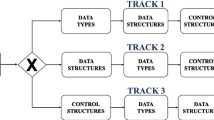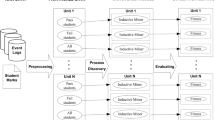Abstract
This paper reports on research that aims to examine what tutoring practices in an online environment can promote students’ self-regulated learning (SRL). First, we propose a theoretically grounded framework of signifiers that can be used to track tutor-student interactions with respect to SRL. Second, we operationalize the framework using log data from a virtual learning environment and process mining approaches. Our results demonstrate that there are structural differences in tutor-learner interactions between the high performing versus low performing tutors. High performing tutors show complex patterns of engagement, which emphasize open-ended questioning and reasoning. Whilst the low performing tutors use a more restricted range of teaching practices that focus on instruction and are more strictly led by the learning platform in which they tutor. We conclude the paper with a discussion of these findings.
Access provided by Autonomous University of Puebla. Download conference paper PDF
Similar content being viewed by others
Keywords
- Self-regulated learning
- Online tutoring
- Process mining
- Virtual classroom environment framework of signifiers
1 Introduction
This paper builds on recent research exploring the application of analytics to measure SRL (e.g. [3, 4]). We explore how process mining can be used to track the influence of tutor practices on learner SRL in online one-to-one human tutoring settings. Our key Research Questions are presented below:
-
1.
Which signifiers can be used to track the influence of tutoring practices on learner SRL, in a Virtual Classroom Environment (VCE)?
-
2.
How can we use process mining to detect variations between high and low performing groups of tutors’ practice, regarding their influence on students’ SRL?
2 Methodology and Analysis
We have followed the methodology set out in [3] to i) Develop a framework of signifiers using a mixed-methods approach, ii) Implement the framework of signifiers using process mining. For our empirical work, we partnered with an industrial supplier named Third Space Learning, which delivers mathematics tutoring for primary school children aged 10 years old. Students and tutors log into a shared online environment, and the student works through a pre-designed online set of questions, with the guidance of a human tutor on an interactive whiteboard. The data available for analysis includes log data from the virtual classroom environment (VCE), learner audio files and tutor audio files. More information on the methods and findings can be found here.
2.1 Developing the Framework of Signifiers
We have built on the research conducted in [7] and adopted the Winne and Hadwin model of SRL [8] as the foundation for our Framework of Signifiers. We have interpreted the model based on the context of our research. More specifically, tutors are regarded as an external Condition, which influence the cognitive and metacognitive Operations of the student across the four phases of SRL. Micro-level processes and signifiers have been identified using a mixed-methods approach. This included a literature review and an empirical review of 50 randomly selected tutoring sessions (Tables 1 and 2).
2.2 Implementing the Framework of Signifiers, Using Process Mining
We collected samples of 55 online tutoring sessions conducted by high and low performing tutors. Tutor performance was determined using human evaluator rankings, with the top fifteenth percentile and bottom fifteenth percentile of tutors being selected respectively. We coded data based on the framework of signifiers, using the approach presented in [4]. We implemented our framework using a proprietary adaptation of Fuzzy Miner called Disco, configured to show only the most significant events and` transitions adjusting the parameters accordingly (Figs. 1 and 2).
3 Discussion
Our analysis showed that the process maps for the low ranked tutor group differed from the process maps for the high ranked tutor group in terms of both the structure of the map and also the types of prominent events and transitions. Overall, there is a relatively narrow range of events that are considered significant in the low-ranked cluster, with tutor-led practices, such as instruction and explanation, being the most prominent. In contrast, the high ranked tutor group exhibits a broader range of significant events and transitions, and the process map is more complex. Tutoring practices extend beyond the platform and include open-ended questions and metacognitive prompts. These findings align with past research [4, 6, 7] and have the potential to be used to i) design intelligent support for tutors in VCEs, ii) tutor training on these behaviours to improve their practice and student SRL.
References
Azevedo, R., Witherspoon, A., Chauncey, A., Burkett, C., Fike, A.: MetaTutor: A MetaCognitive tool for enhancing self-regulated learning. In: Cognitive and metacognitive educational systems: AAAI Fall Symposium (FS-09-02), pp. 14–19 (2009)
Blackwell, L., Trzesniewski, K., Dweck, C.S.: Implicit theories of intelligence predict achievement across an adolescent transition: a longitudinal Study and an intervention. Child Dev. 78, 246–263 (2007)
Chi, M., Wylie, R.: The ICAP framework: linking cognitive engagement to active learning outcomes. Educ. Psychol. 49(4), 219–243 (2014)
Cukurova, M., Khan-Galaria, M., Millán, E., Luckin, R.: A learning analytics approach to monitoring the quality of online one-to-one tutoring. J. Learn. Anal., 1–16 (2022). https://doi.org/10.18608/jla.2022.7411
Howard-Rose, D., Winne, P.H.: Measuring component and sets of cognitive processes in self-regulated learning. J. Educ. Psychol. 85(4), 591–604 (1993)
Hrastinski, S., Stenbom, S., Benjaminsson., S & Jansson., M,: Identifying and exploring the effects of different types of tutor questions in individual online synchronous tutoring in mathematics. Interact. Learn. Environ. 29(5), 1–13 (2019)
Khan-Galaria, M., Cukurova, M., Luckin, R.: A framework for exploring the impact of tutor practices on learner self-regulation in online environments. In: Bittencourt, I.I., Cukurova, M., Muldner, K., Luckin, R., Millán, E. (eds.) AIED 2020. LNCS (LNAI), vol. 12164, pp. 135–139. Springer, Cham (2020). https://doi.org/10.1007/978-3-030-52240-7_25
Winne, P.H., Hadwin, A.F.: Studying as self-regulated learning. In: Hacker, D.J., Dunlosky, J., Graesser, A.C. (eds.) Metacognition in Educational Theory and Practice, pp. 277–304. Lawrence Erlbaum Associates, Mahwah (1998)
Winne, P.H.: Learning analytics for self-regulated learning. In: Lang, C., Siemens, G., Wise, A., Gašević, D. (eds.) Handbook of learning analytics, pp. 241–249. Society for Learning Analytics Research, Beaumont, AB (2017)
Winne, P.H.: Cognition and metacognition within self-regulated learning. In: Schunk, D., Greene, J. (eds.) Handbook of self-regulation of learning and performance, 2nd edn., pp. 36–48. Routledge, New York (2018)
Author information
Authors and Affiliations
Corresponding author
Editor information
Editors and Affiliations
Rights and permissions
Copyright information
© 2022 Springer Nature Switzerland AG
About this paper
Cite this paper
Khan-Galaria, M., Cukurova, M. (2022). Monitoring Tutor Practices to Support Self-regulated Learning in Online One-To-One Tutoring Sessions with Process Mining. In: Rodrigo, M.M., Matsuda, N., Cristea, A.I., Dimitrova, V. (eds) Artificial Intelligence in Education. Posters and Late Breaking Results, Workshops and Tutorials, Industry and Innovation Tracks, Practitioners’ and Doctoral Consortium. AIED 2022. Lecture Notes in Computer Science, vol 13356. Springer, Cham. https://doi.org/10.1007/978-3-031-11647-6_80
Download citation
DOI: https://doi.org/10.1007/978-3-031-11647-6_80
Published:
Publisher Name: Springer, Cham
Print ISBN: 978-3-031-11646-9
Online ISBN: 978-3-031-11647-6
eBook Packages: Computer ScienceComputer Science (R0)






